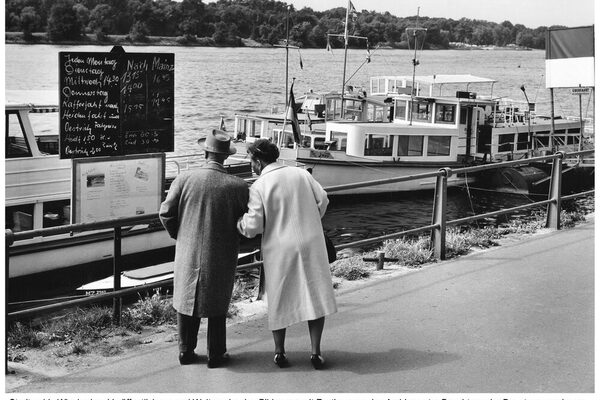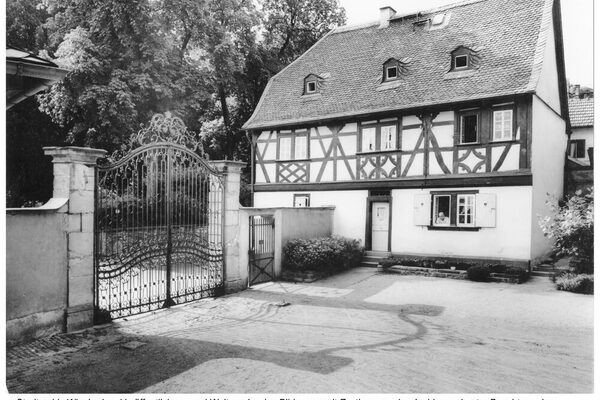Biebrich
Archaeological finds prove that Biebrich has been continuously settled and used for thousands of years. The "villa Biburg" was first mentioned in 874 and, according to Hellmuth Gensicke, the place name refers to a prehistoric or Roman fortification. Biebrich was home to a landing stage and a royal ferry terminal, which formed the end point of two important transport routes to Mainz via the Taunushöhe. The Rhine ferry connected Biebrich with Mainz and passed to the Counts of Nassau as an important imperial fiefdom in 1336. A "Königsbeunde" (royal estate) named in 1307 in the immediate vicinity of the ferry refers to the Carolingian royal court.
At this time, Biebrich was a village with a Fronhof in the center and the farms ("mansus") of dependent farmers over which the king had power of disposal. This royal estate included Mosbach, just 2 km to the north, as well as "Bruderode", around 6 km away. The responsible parish church was located in Mosbach and was first mentioned in 1085. In 1472, it passed to the Eberbach monastery, in whose possession it remained until 1803. A priest, Dietrich vom Kirchhof, is first mentioned before 1190. The first Protestant pastor took office in 1560. A schoolmaster is mentioned as early as 1563; he also held the office of bell ringer and court clerk. Until 1729, the children of Biebrich also attended school in Mosbach, but it was not until 1733 that Biebrich was given its own school. A document from 1275, which describes the rights of the Selz monastery in the villages, provides information on the village structure in Biebrich and Mosbach. According to this document, the bailiff, as representative of the monastery, was to hold court in the "curtis" of Biebrich three times a year. Other officials were the mayor, the field archers and two foresters. In 1275, Selz Monastery sold Biebrich to Eberbach Monastery and in 1296 to King Adolf of Nassau, who in turn transferred "the Court of St. Adelheid, the Court of Armenruh and the Court in Mosbach" with other accessories to Klarenthal Monastery in 1298. The bailiff or Schultheiß Hertwich, who exercised jurisdiction on behalf of the sovereign, is documented from 1267. A separate court seal was used from 1549. The oldest seal impression dates from 1620 and shows a beaver with a key, the latter a reference to the church patron saint, St. Peter. There is evidence of a pillory in 1601 and a local prison or "Stimbert" in 1619. The castle, first mentioned in 1462, was a moated castle located on the site of today's Mosburg in the rear part of Biebrich Castle Park.
Biebrich and Mosbach are mentioned together from the very beginning. Both villages were fortified with walls and moats in the 14th/15th century. Mosbach is referred to as a village as early as 1531 and together with Biebrich in 1597. In addition to the mayors, there were municipal offices such as that of the head of the municipality and municipal servants such as shoemakers, fire runners, shepherds and night watchmen. In 1563, 181 heads of household were counted in Biebrich and Mosbach. After the Thirty Years' War, the number fell to 33 subjects and three widows in 1651. In 1746 there were 912 inhabitants in both villages, i.e. 205 families in 152 houses. There is evidence of Jews in Biebrich since 1642.
The community experienced a new upswing when Prince Georg August Samuel zu Nassau-ldstein began building the palace in 1700/01. As Biebrich developed into a residence, a large number of court officials and tradesmen settled in the town, and Biebrich soon received its first garrison.
After 1866, industrialization had a dominant influence on Biebrich's history, favoured by its location on the Rhine. Since the use of steam power for Rhine shipping in the 1820s, the elevation of Biebrich to a Rhine port with the right to a free warehouse on 31.03.1831 and Nassau's accession to the German Customs Union (1836), new life sprang up on the banks of the Rhine. Biebrich became the "outer harbor" of Frankfurt. Biebrich and Mosbach were connected to the railroad in 1840 and 1856 respectively. Due to these favourable transport conditions, industry began to establish itself: 1857 is the founding year of the Rheinhütte, in 1858 the fertilizer factory of Heinrich Johann Albert was built, in 1863 the chemical factory of Paul Wilhelm Kalle, in 1864 the cement works of Gustav Wilhelm Dyckerhoff. Albert and Dyckerhoff were forced to expand their factories on Hesse-Darmstadt soil, on the other side of the Landgraben. Nevertheless, they must always be seen in the context of Biebrich's history, as the entire workforce was based in Biebrich. The population now grew by leaps and bounds (1840 = 3,000; 1867 = 6,000; 1875 = 7,700; 1888 = 9,600; 1895 = 12,300; 1905 = 19,000 inhabitants). In the last third of the 19th century, in the so-called founding years, Biebrich, which had already grown together with Mosbach since 1850 through the development of Wiesbadener Straße (today Am Schlosspark), finally developed into an industrial town. Smaller factories and several craft businesses also settled in Biebrich.
The significant industrial sector and the strong growth in population placed increased demands on the municipal administration. The old town hall in Mosbach (Didierstraße 3) was replaced in 1876 by a new building designed by architect Georg Friedrich Fürstchen. Biebrich was granted town rights in 1882; Mayor Rudolf Vogt was appointed Lord Mayor. The name Biebrich-Mosbach, which had been used for a long time, was changed to "Stadt Biebrich am Rhein" in 1893. This made Biebrich the largest town in the district at the time, alongside Wiesbaden. Water pipes were laid, the town was newly sewered in 1893, Biebrich was connected to the electricity grid in 1895 and received gas lighting in 1900. From 1896, the streets were paved and new schools were established. The years leading up to the First World War were a time of prosperity for Biebrich, although this came to an end after 1918. The town came to the brink of bankruptcy and joined the financially stronger Wiesbaden. The incorporation treaty came into force on 01.10.1926.
After Hitler's so-called seizure of power, the people in Biebrich, as in the rest of the German Reich, were "brought into line". Political parties, trade unions and church associations ceased to exist. Around 30 Biebrich citizens were murdered by the Gestapo in concentration camps and penitentiaries for racist motives, their religion or their political convictions. During the so-called Reichskristallnacht in November 1938, Biebrich's synagogue at Rathausstraße 37, built in 1830, was also a victim of the blind rage. On the bombing nights of December 18, 1944, January 13 and February 2, 1945, over 800 homes were destroyed, leaving around 1,000 families homeless. With the invasion of the American troops on 28.03.1945, the haunting of the "Third Reich" was over.
After the currency reform in 1948, a steady upward trend began as conditions stabilized and the economy slowly began to flourish, which was evident in the lively construction activity. At the end of the 1950s, new residential areas were built on Gräselberg and Adolfshöhe, and in the 1980s also in Parkfeld. The traffic situation was improved and new industrial plants moved in. This was followed by the construction of new schools and the expansion of existing ones, the construction of new sports facilities and the Galatea complex on the site of the former streetcar depot. There are five Protestant and four Catholic parishes in the district. The main Protestant church was Biebrich's only church until the consecration of the Catholic parish church of St. Marien in 1876. As the population grew, more churches were built, such as the Herz-Jesu-Kirche in Mosbach as the second Catholic church in 1898 and the Oranier-Gedächtnis-Kirche on the banks of the Rhine as the second Protestant church in 1905. The Albert-Schweitzer-Gemeinde (Protestant), St. Hedwig (Catholic), Heilig-Geist-Kirche (Protestant), St. Kilian (Catholic) and Lukasgemeinde (Protestant) churches were built in the second half of the 20th century.
Biebrich has produced important personalities, such as the cultural scientist Wilhelm Heinrich von Riehl, the Jewish scholar Seligmann Baer, the philosopher Wilhelm Dilthey, the classical philologist Hermann Diels, the astrophysicist Erwin Finlay Freundlich, the resistance fighter Colonel General Ludwig August Theodor Beck and the Jewish member of the Reichstag Tony Sender, the physicist Walther Gerlach and the mathematician and logician Karl Schröter (1905-1977). In 1862, Richard Wagner created Act 1 and the prelude to Act 3 of his work "Die Meistersinger von Nürnberg" in a country house on the Rhine. The film pioneer and producer Edwin Georg Dengel was born in Biebrich, as was the pianist, bandleader and singer Paul Kuhn and, in 1944, the footballer Jürgen Grabowski, who played for Eintracht Frankfurt for many years and won the World Cup with the German national soccer team in 1974.
Literature
Dehio, Georg: Handbook of German Art Monuments. Hesse II. The administrative district of Darmstadt, edited by Folkhard Cremer [et al.], Munich, Berlin 2008 [pp. 78ff.]
Biebrich on the Rhine: 874-1974. chronicle. Edited by Faber, Rolf on behalf of the working group "1100 Jahre Biebrich", Wiesbaden 1974.
Faber, Rolf: Moskebach - Biebrich - Mosbach: 991-1991. chronicle. Ed.: Verschönerungs- und Verkehrsverein Biebrich am Rhein e.V., Wiesbaden- Biebrich 1991.
Gockel, Michael: Article Biebrich. In: The German royal palaces [pp. 8-15].
Handbook of Historical Sites in Germany, Vol. 4: Hesse. Ed.: Sante, Georg Wilhelm, Stuttgart 1976 [p. 49 f.].

